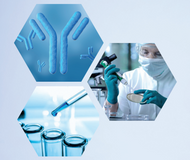Why is the Measurement of Monoclonal Antibodies (mAbs) Important?
Dec 9th 2021
In the past century, pharmaceutical drugs mostly have been chemical substances with a certain well-known chemical formula. Usually these chemicals have been rather unspecific and have shown considerable side effects. During the last 2 decades several big pharmaceutical companies have developed well designed highly specific antibodies for therapeutic use and they will continue to do so also in future. Therefore, they are used in many different medical areas with great success.
The main
areas are
-
rheumatology/autoimmune disorders (rheumatoid arthritis)
-
gastro-intestinal disorders (Crohn's disease)
-
oncology (breast and colon cancer, myeloma)
-
dermatology (psoriasis, melanoma)
-
ophthalmology (macular degeneration)
-
infectious disease (RSV)
-
bone disease (osteoporosis)
The
most widely used mAb drugs are designed to tightly
bind TNF-α in subjects. This is important as free TNF-α will trigger
inflammation and therefore finally will destroy the cells. If TNF-α (which is called the target) is tightly bound
to the mAb it is inactivated and the
clinical symptoms of the illness are significantly improving.
When
a subject is treated with such mAbs, it might be useful to measure the
concentration of these drugs which still are free and represent the capacity of the drug for catching the
target (e.g. TNF-α). IBL-America offers ELISA kits that containmicrotiter plates (MTP) that are coated with the target molecule (e.g. TNF-α). This immobilized target
will catch all free drug molecules from the sample during the first incubation.
During the following incubation, a conjugate will label the
immobilized drug and can be detected by adding TMB. In such assay
design, the immobilized target (e.g. TNF-α)
will bind to any drug which is specific for this target. In
order to avoid
this unspecific binding, an alternative ELISA type which
is using a monoclonal antibody as a catcher on the surface of the MTP. This
assay type only and specifically is measuring one drug and does not cross react
with any other drug.
The problem of Immunogenicity
At
the turn of the century already 9 therapeutic mAbs have been approved by the FDA. Meanwhile (beginning of 2016) this
number has increased to more than 200. Surely the number still will continue to increase.
At the beginning, the therapeutic mAbs have been purely murine ones (their names end with -omab). Unfortunately, these murine mAbs usually have shown a significant degree of immunogenicity. This is the development of antibodies by the immune system of the subject against the drug. This effect will reduce the amount of free mAb (drug) in the subject significantly. If this happens then the treatment should be changed to another therapeutic mAb (drug) which is still unknown to the immune system of the subject.
The next logical step was the development of chimeric mAbs (their names end with -ximab). In this case the Fc part of the mAb is a human one, while the Fab part is still of murine origin. Therefore, still in many cases the immune system of the subject recognizes the non-human origin (of the Fab part) and produces its own antibodies to defend the mAb (drug).
Later
the pharmaceutical companies have developed humanized mAbs (their names end with -zumab). In these mAbs only a small part of the Fab is
of murine origin. This again reduces the percentage of subjects showing
immunogenicity. The next stage was the development of human mAbs (their names end with -mumab) which (almost) do not show murine protein sequences anymore in their
Fab parts. This was another step in the efforts to reduce the immunogenicity of
the mAbs for therapy. Nevertheless, also the "human" mAbs do not originate from the body
of the subject and therefore still might show some immunogenicity. At the
beginning (at the time of chimeric mAbs) the percentage of subjects showing
immunogenicity usually has been in the 2-digit numbers. Meanwhile (thanks to
humanized or human mAbs) this percentage has dropped to
1-digit numbers.
As any degree of immunogenicity reduces the efficiency of the drug (mAb) it often is interesting to measure whether the immune system of the subject is developing antibodies against the drug. This can be achieved using the anti-drug test kits which also are included in the ImmunoGuide product line. These test kits so far are measuring the free antibodies, meaning just the antibodies, which are not yet bound to the drug. Therefore, it is best if the blood sample from the subject is taken just before the next treatment or at least 2 weeks after the last treatment.
For research use only. They are not for use in clinical procedures.

